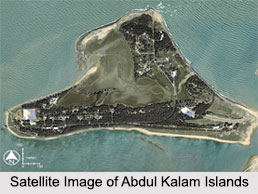 Island Cities of East India showcase the development of tourism near the coast line of Bay of Bengal. Some of the islands are also located in the deltaic region of Ganga River and the opening of Bay of Bengal. While the Andaman and Nicobar Islands allures the tourists with the sea beaches and the adventure sports.
Island Cities of East India showcase the development of tourism near the coast line of Bay of Bengal. Some of the islands are also located in the deltaic region of Ganga River and the opening of Bay of Bengal. While the Andaman and Nicobar Islands allures the tourists with the sea beaches and the adventure sports.
Abdul Kalam Island
APJ Abdul Kalam Island which was formerly known as Wheeler Island is located in Odisha. The Integrated Test Range missile testing facility is located on APJ Abdul Kalam Island.
Island Cities of West Bengal
Sagardweep or Sagar Island is one of the most important islands in West Bengal. It is not an eco tourism spot. It is a pilgrimage tourism spot in India, which is known as Gangasagar. Sagardweep or Sagar Island comes under South 24 Parganas District in West Bengal. Every year on the day of Makar Sankranti (14 January), hundreds of thousands of Hindus gather to take a holy dip at the confluence of Ganga River and Bay of Bengal and offer prayers in the Kapil Muni Temple.
Jambudip is an isolated island in West Bengal. Located in the southern fringe of Bengal, Jambudip is attracted to the tourists who are visiting Bakkhali and Frasergaunj. These two are the leisure tourism destination in South 24 Parganas District of West Bengal.
Island Cities of Andaman and Nicobar Islands
Andaman and Nicobar Islands is one of the seven union territories of India. These are a group of islands at the juncture of the Bay of Bengal and Andaman Sea. The territory`s capital is the Andamanese town of Port Blair. Andaman and Nicobar Islands are the major leisure tourism centers with exotic beaches and pristine islands. These beaches and islands are having equally exotic names, wonderful opportunities for adventure sports like snorkeling, scuba diving and sea-walking. The tourist attractions in Andaman and Nicobar Islands are Cellular Jail, Mahatma Gandhi Marine National Park, Andaman Water sports complex, Chatham Saw Mill, Mini Zoo, Corbyn`s cove Beach, Chidiya Tapu, Wandoor Beach, Forest Museum, Anthropological Museum, Fisheries Museum, Naval Museum (Samudrika), Ross Island and Viper Island. While Havelock island is famous for leisure tourism, Radhanagar Beach, Neil Island is ideal for Scuba diving and snorkeling; Cinque island, Saddle peak, Mt Harriet and Mud Volcano are the popular eco and nature tourism areas in Andaman Nicobar Islands. There are 1,374 registered small-scale, village and handicraft units in Andaman and Nicobar Islands. There are other industrial belts, which are engaged in the production of polythene bags, PVC conduit pipes and fittings, paints and varnished, fiber glass and mini flour mills, soft drinks and beverages, etc. The small scale and handicraft units are also engaged in shell crafts, bakery products, rice milling and furniture making.



















